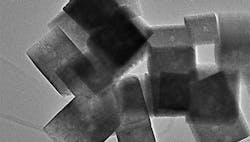Electrocatalytic Route Eases Urea Production
Manufacture of urea relies on the well-established two-stage Haber-Bosch process. However, a highly selective single-stage electrocatalytic route may challenge that method, hope scientists in Singapore. Their patented process, which reacts nitrate ions and carbon dioxide at ambient conditions with an indium hydroxide catalyst, provides comparable efficiency to the Haber-Bosch method while avoiding its severe operating conditions.
The process boasts yield and catalytic selectivity that are up to 40% higher than other electrocatalytic routes to urea production, says team leader Alex Yan, a professor at Nanyang Technological University’s School of Materials Science and Engineering, Singapore.
“Our method essentially manipulates the chemical reaction process to become highly selective,” he adds.
Faradaic efficiency, nitrogen selectivity and carbon selectivity reach 53.4%, 82.9% and almost 100%, respectively. This efficiency matches that of the Haber-Bosch process, according to Yan and his team, but without its need for pressures approaching 200 atmospheres and temperatures up to 450°C.
The researchers also found the catalyst suppresses hydrogen evolution while creating a low energy barrier for the all-important C-N coupling (Figure 1).
An article in a recent issue of Nature Sustainability describes their work.
Yan and his team currently are striving to refine catalytic selectivity to speed up reaction time. They also plan to develop a prototype to demonstrate scaled-up urea production.
“This prototype is still at the stage of laboratory research. To realize scaled-up urea production through the sustainable electrocatalysis route, three main issues should be addressed: urea yield, catalyst stability and selectivity,” he notes.
These three factors also would pose challenges to commercial-scale production, although Yan believes the main chemical and engineering challenges could lie in the eventual extraction and purification of urea from the electrolyte.
A solar-powered prototype also interests the researchers. “The idea is intriguing but we have not started relevant work yet. However, urea selectivity is dependent on applied potential, so the photoelectrochemical approach might be feasible,” Yan explains.
The simplicity of the process eventually could lead to its adoption at both large and small scales, he feels, perhaps with agricultural areas generating their own urea for fertilizers from mobile or modular units.
While the new process suggests an appealing route for urea production, it also provides a deep insight into the underlying chemistry of the C–N coupling reaction that could guide the sustainable synthesis of other indispensable chemicals, he stresses.
“Many important chemicals might be produced through electrocatalytic C–N coupling reaction, such as methylamine. We have not investigated any other chemicals yet, but we may do so if we clearly elucidate the C–N coupling mechanism in urea synthesis,” Yan concludes.
